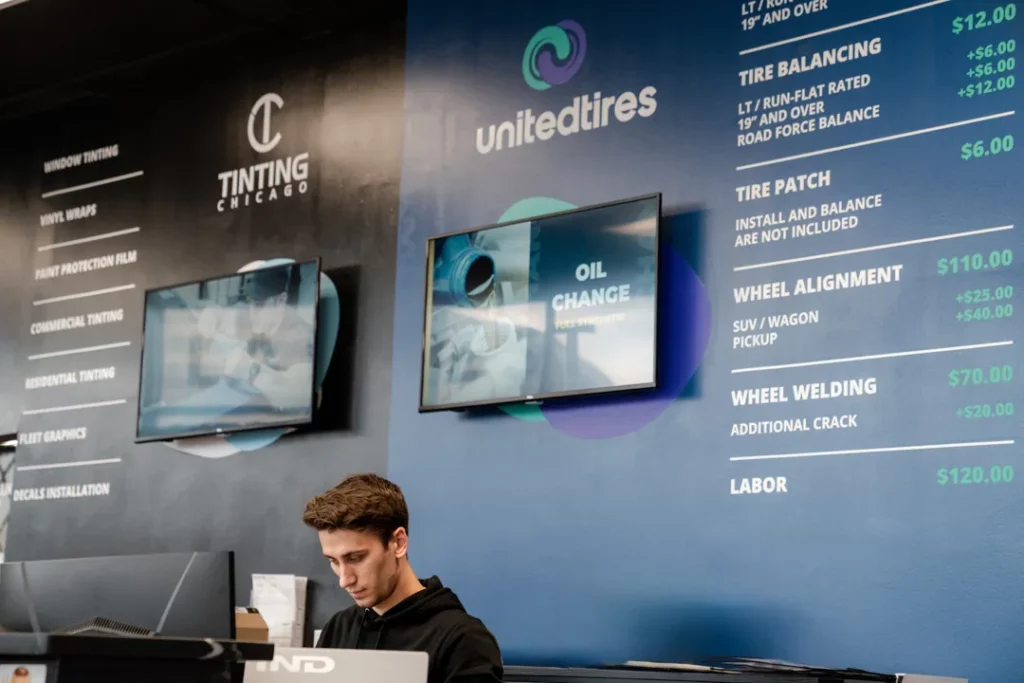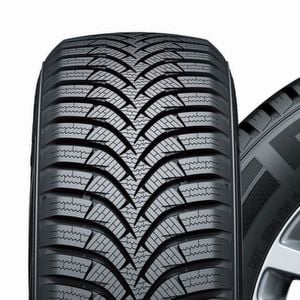Last Updated on 19.11.2024 by hrushetskyy

As a (potential) tire shop owner, you must calculate gross profit margin and markup before even starting a business. Optimizing these two key metrics strategically is the only way to position yourself for growth and expansion. Our UTires management team created this blog post specifically for prospective tire shop owners. Learn how to compute margin and markup from the experts.
Understanding margin and markup in tire shops
Markup and margin are fundamental concepts in tire shop financial management. How well these financial metrics are managed often determines the difference between a thriving and a merely getting-by shop, as they are key indicators of the company’s financial health. Regularly analyzing both markup and margin helps us, tire shop owners, make a healthy profit and not just cover costs. However, there are many nuances behind these seemingly simple formulas. Let’s dive deeper into profit margin and markup.
Defining gross profit margin
Gross profit margin shows how much money a business retains after accounting for the cost of goods sold (COGS). A company’s gross profit margin is essential for assessing financial performance and operational efficiency.
It is calculated by subtracting COGS from total revenue and expressing the result as a percentage. This percentage reflects the portion of revenue that remains as profit after covering the direct costs of producing and selling products, and it helps assess how efficiently a tire shop is managing its product and service sales.
The gross profit margin is calculated by dividing the gross profit by the total revenue and then multiplying by 100.
Defining markup percentage
Markup is the amount added to the cost of goods sold, operational expenses, labor, and desired profit margins, expressed as a percentage of the cost price. According to Tekmetric’s Auto Repair Industry Index, the average markup percentage for tire shops is around 35%.
This figure provides a useful benchmark for tire shops when setting prices. A well-calculated markup is your guarantee that the selling price will cover all costs and include a reasonable profit.
Markup percentage is calculated by dividing the dollar markup by the cost price and multiplying it by 100.
Gross profit margin calculation in tire shops

Maintaining a high gross profit margin is super important for tire shops. It indicates efficient cost management and strong pricing strategies, which can lead to higher net profits and a more competitive position in the market.
To calculate gross profit, use the following formula:
Gross Profit = Total Sales Revenue – COGS
Where COGS includes direct costs such as materials, labor, and overheads. Once you have the gross profit, you can determine the gross profit margin, which is expressed as a percentage of total sales revenue. The formula for gross profit margin is:
Gross Profit Margin = (Gross Profit / Total Sales Revenue) x 100
For example, if a tire shop has total sales revenue of $1,000 and COGS of $300, the gross profit would be $700. The gross profit margin would then be 70% (($700 / $1,000) x 100).
The company’s gross profit margin formula is a simple yet powerful tool for evaluating profitability, including gross profits.
Other important profit margins include net profit margin and operating profit margin.
The net profit margin is the net profit expressed as a percentage of total sales revenue, while the operating profit margin is the operating profit expressed as a percentage of total sales revenue.
After all operating expenses (rent, salaries, utilities, insurance, advertising, etc.) and other costs are deducted from the gross profit (GP) margin, the remainder is your net profit before taxes.
Little or no net profit will remain if the GP margin is not sufficiently large.
Some businesses need a higher gross profit margin to stay profitable because operating costs can differ a lot from one type of business to another. On the flip side, if your operating expenses are on the lower side, even a smaller gross profit margin can still lead to solid profits.
Here’s a comparison to make this clearer: operating expenses and net profit are divided into two parts of the gross profit margin. When you add their percentages (based on net sales), you get the total gross profit margin.
Calculating markup for tires and services

Markup and gross profit margin on a single product or group of products are often confused. The reason for this is that, when expressed as percentages, the margin is always calculated as a percentage of the selling price, while markup is traditionally calculated as a percentage of the seller’s cost. The equation is:
(Total Sales Cost of Sales)-s-Cost of Sales
Using the numbers from the previous example, if you purchase goods for $300 and sell them for $1,000, your markup is $700. As a percentage, this markup equals 233% (($1,000 – $300) ÷ $300). In other words, if your business requires a 70% margin to be profitable, your average markup must be 233%.
This example illustrates that while markup and margin may be the same in dollar terms ($700), they represent different percentages (233% vs. 70%). Many new businesses fail to meet their profit expectations because owners mistakenly believe that a markup of X percent will result in the same margin.
Example calculation
Opening a tire shop: expert tips to boost revenue

1. Analyze your segment of the tire industry
To run a successful tire shop, you must understand industry standards and benchmarks. Here are four essential metrics you should know.
- The overall average profit margin across the tire supply chain typically ranges from 18% to 22%.
- Tire manufacturers generally maintain 15% and 25% profit margins before factoring in distribution and retail costs.
- Tire retailers often see profit margins in the 20% to 30% range, though high-volume retailers may operate with slightly lower margins.
- Typical gross profit margins in the tire industry can vary between 30% and 50%. Companies strive for high gross profit margins as a sign of effective operations and profitability.
2. Compare margins to industry averages
Your company’s financial health heavily relies on competitive research. Don’t underestimate its importance—always be on the lookout for strategies to boost revenue. By comparing margins within the same industry, you, as a tire shop owner, can identify top-performing businesses and uncover strategies that contribute to their success.
Start by comparing your KPIs (key performance indicators), such as the average repair order value and monthly revenue, to those of your successful competitors. This can provide important insights into how you can enhance your product offerings and services.
3. Set realistic goals
As you establish your shop and build your customer base, your focus should be on steadily increasing your gross profit margin. This is where your market research proves valuable—use it to gauge the typical profit range for a company of a similar size.
Expert tips to improve gross profit margin

The highest profit margins come from using a mix of smart strategies you can implement as your business gains momentum. Understanding other profit margins, such as operating and net profit margins, is also crucial for a comprehensive view of your company’s profitability. These strategies include cutting costs, streamlining operations, boosting revenue by strengthening relationships with suppliers and loyal customers, attracting new clients, and more. Let’s dive into the most important ones!
10 strategies to reduce costs
Reducing costs is one of the most effective ways to boost your tire shop’s profit margins. It’s not just about cutting corners—it’s about being smart with your spending and operations. Here are some simple but powerful ways to do that:
- Negotiate better supplier deals: Work with suppliers to secure bulk discounts, extended payment terms, or loyalty incentives that lower the cost of goods sold (COGS).
- Buy in bulk: Purchase parts and tires in larger quantities to take advantage of volume discounts and reduce per-unit costs.
- Optimize inventory management: Avoid overstocking or understocking by analyzing sales trends and stocking only what’s needed. This will reduce storage costs and minimize waste.
- Streamline operations: Implement digital vehicle inspections or automated systems to reduce labor time and increase efficiency in day-to-day processes.
- Cross-train employees: Train staff to handle multiple tasks, minimizing the need for extra hires and improving operational flexibility.
- Outsource non-core tasks: Consider outsourcing services like accounting, marketing, or IT to specialized companies, reducing internal labor costs.
- Reduce energy consumption: Upgrade to energy-efficient equipment or lighting and minimize waste to lower utility bills.
- Preventive equipment maintenance: Regularly maintain tire machines and other shop equipment to avoid costly repairs or replacements due to breakdowns.
- Standardize procedures: Develop efficient workflows for routine tasks to reduce wasteful labor and streamline operations.
- Leverage tax incentives and credits: Take advantage of any available local or federal tax incentives or credits for energy efficiency or hiring practices.
10 strategies to increase revenue
Boosting your revenue is another key strategy for improving your gross profit margin. Simple tactics can encourage repeat business, helping you bring in more revenue over time. Here are several working tactics by our marketing and sales department experts:
- Offer loyalty programs: Encourage repeat business by rewarding returning customers with discounts, free services, or points that can be redeemed for future purchases.
- Create targeted marketing campaigns: Use social media, email newsletters, and local advertising to attract new customers and promote special deals or services.
- Upsell additional services: After installing tires and/or performing tire alignment/balancing/rotation, offer complimentary services like brake checks.
- Bundle services: Combine related services (e.g., oil changes and tire inspections) at a discounted rate to increase the overall ticket price.
- Introduce seasonal promotions: During peak seasons, offer tire discounts, winterization services, or free tire checks to attract more customers.
- Expand product offerings: Sell high-margin accessories such as custom wheels, tire pressure monitoring systems (TPMS), or specialty tires.
- Offer financing options: Make larger purchases more accessible by offering flexible payment plans or financing for tire packages or repairs.
- Partner with local businesses: Form partnerships with car dealerships, auto repair shops, or fleet companies to create referral opportunities.
- Develop a subscription service: Offer maintenance packages where customers pay monthly for regular tire checks, rotations, or alignments.
- Enhance your customer service: Exceptional customer experiences lead to positive reviews and word-of-mouth referrals, increasing repeat business. At UTires, we have over 250,000 positive customer reviews across different platforms. That should be your goal, too!
Expert tips to optimize markup for a maximum profit
When it comes to maximizing profits in your tire shop, optimizing your markup is key. One smart strategy is to use a scaled parts markup—applying higher markups to lower-cost parts and smaller markups to the more expensive ones. This works because customers are generally more comfortable paying a bit more for inexpensive items, while larger-ticket parts need to feel like a better deal. But optimizing markup doesn’t stop there!
8 strategies to optimize markup
Here are 8 more strategies to help you fine-tune your pricing for maximum profit:
- Segmented pricing for customer types: Offer different pricing strategies based on customer segments, such as wholesale, retail, or fleet clients. Tailoring your markup to each group’s buying habits can help you stay competitive while maximizing profits.
- Bundle products and services: Offer package deals (e.g., a tire purchase with free rotation or alignment) to increase perceived value. You can apply a slightly higher markup within the bundle while giving customers a feeling of getting more for their money.
- Monitor competitors’ pricing: Stay competitive by regularly checking your competitors’ pricing. Adjust your markup accordingly to balance profit margins and attract price-sensitive customers.
- Use dynamic pricing: Adjust prices based on demand, seasonality, or inventory levels. For example, you can apply a slightly higher markup during peak tire seasons due to increased demand.
- Offer premium options: Customers are often willing to pay more for top-quality, high-end, or premium products. Apply a higher markup to premium tires or specialty products.
- Add value through services: If your shop offers expert customer service, extended warranties, or additional perks, customers may be more accepting of higher markups as they perceive added value.
- Track customer preferences: Pay attention to which products and services are most popular and profitable. You can experiment with a slightly higher markup for high-demand items since customers are likely to pay a premium for items they trust.
- Implement psychological pricing: Price products just below whole numbers (e.g., $99.99 instead of $100) to make them seem more affordable. Even small adjustments in pricing can increase sales without significantly lowering markups.
Using these strategies alongside your current approach gives you more flexibility to optimize your markup, boost profitability, and keep your customers satisfied.
Common mistakes to avoid

Running a successful tire shop means more than just knowing your products—it’s about mastering your pricing strategies and staying in tune with the market. Let’s take a look at some of the most common mistakes tire shop owners make and how to avoid them.
Overpricing and underpricing
One of the biggest challenges is finding that sweet spot with pricing. Overpricing your products can push customers away and straight into the arms of your competitors. If your prices are too high, you could lose out on market share and reduce your gross margin. Even loyal customers might hesitate to pay higher prices if they feel they can get a better deal elsewhere.
On the flip side, underpricing is equally dangerous. Setting prices too low can erode your profit margins to unsustainable levels, and worse, it might make customers question the quality of your products. People often associate low prices with lower quality, so you could unintentionally damage your brand’s reputation.
The key is finding that perfect balance between staying competitive and sacrificing profitability. Regularly review your pricing strategy, factor in market conditions, and make adjustments to stay in that sweet spot.
Ignoring market trends
Another common pitfall is ignoring market trends. The tire industry is constantly evolving, and you must stay on top of these changes and keep your inventory aligned with customer demands. For example, as the demand for electric vehicles grows, so does the need for EV tires. If you’re not paying attention to such things, you risk overstocking tires that are no longer in demand or missing out on products that could be hot sellers.
And it’s not just about keeping up with tire types—technological advancements like smart tires with real-time sensors are also becoming more popular.
Online tools and resources for efficient operations

In today’s fast-paced world, using the right tools and resources can make all the difference in running a tire shop smoothly.
Shop management software
Shopmonkey is a customizable cloud-based solution for managing everything from digital vehicle inspections to invoicing. It even allows you to take photos and videos during inspections and add notes so your customers can see exactly what’s going on with their vehicle.
Accounting and profitability tracking
Using tools like income statement templates and accounting software helps you track profitability and overall performance. Automating this process saves time and reduces the risk of errors. You can generate clear, easy-to-read reports that help you stay on top of your financial health and quickly identify areas for improvement. QuickBooks, FreshBooks, and Xero generate financial statements, manage supplier payments, and handle payroll.
Customer engagement tools
BayIQ can help you improve customer engagement and shop efficiency. It streamlines operations with automated marketing, loyalty programs, and online reviews. Plus, it analyzes data, giving insights into your customer base and helping you make better business decisions.
Digital payment systems
Offering customers multiple payment options, including contactless and online payments, speeds up transactions and improves customer satisfaction. Square or PayPal integrates easily with many shop management tools, making the payment process easy both for your team and customers.
Inventory management systems
Managing inventory can be a challenge, but using inventory management systems can help you keep track of stock levels, avoid over-ordering, and ensure you always have the products your customers need. Tools like Fishbowl integrate with accounting software and automate reordering processes, so you can focus more on running your business and less on tracking inventory manually.
Using these online tools and resources, your tire shop can run more efficiently, improve customer satisfaction, and ultimately increase profitability. It’s all about finding the right mix of technology to streamline your operations while keeping things simple and effective for your team.
Computing margin and markup: tire shops’ key to success
Mastering margin and markup is a game-changer for any tire shop. It’s not just about covering costs—it’s about setting smart prices that attract customers while keeping your profits healthy. Whether you’re new to the game or fine-tuning your existing operation, consistently checking and adjusting your pricing strategy helps you stay competitive and profitable. Keeping a close eye on these metrics will boost your bottom line and set your tire shop up for long-term success and growth.
Frequently Asked Questions
What is the profit margin for a tire shop?
The profit margin for a tire shop typically ranges between 25-50%, with factors like brand, tire type, and supplier purchase volume influencing it. Upselling high-margin tires or additional services can further improve profitability.
What is the difference between gross profit and net profit?
The main difference between gross profit and net profit is that gross profit is calculated by subtracting the cost of goods sold from revenue, while net profit is determined by subtracting all operating expenses from the gross profit. This helps in understanding the overall profitability of a business.
How do I calculate the gross profit margin?
To calculate the gross profit margin, subtract the cost of goods sold from total revenue, divide the result by total revenue, and multiply by 100.
What is a good markup percentage for tire shops?
The Auto Repair Industry Index suggests that tire shops should have a markup percentage of around 35%. This can help ensure profitability and cover business expenses.
Why is it important to compare my tire shop’s profit margins to industry averages?
Comparing your tire shop’s profit margins to industry averages is important to assess your competitive position and identify areas for improvement. This can help you stay competitive in the market and maximize profitability.
Share the Knowledge

